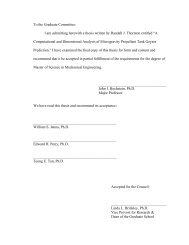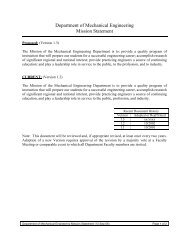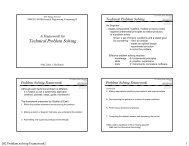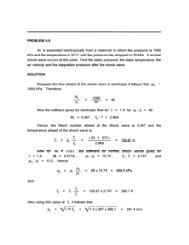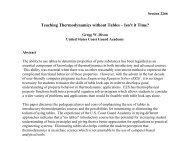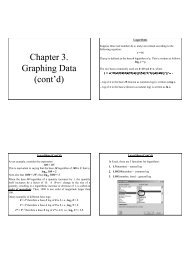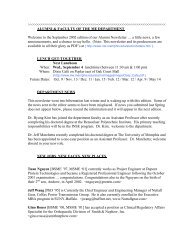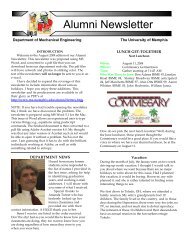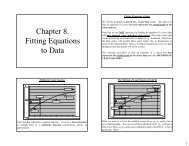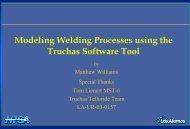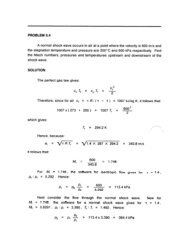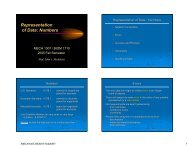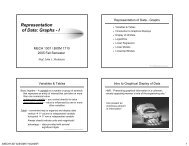MECHANICS of FLUIDS LABORATORY - Mechanical Engineering
MECHANICS of FLUIDS LABORATORY - Mechanical Engineering
MECHANICS of FLUIDS LABORATORY - Mechanical Engineering
Create successful ePaper yourself
Turn your PDF publications into a flip-book with our unique Google optimized e-Paper software.
Incompressible Flow Through a Meter<br />
Incompressible flow through a venturi and an<br />
orifice meter was discussed in Experiment 9. For<br />
our purposes here, we merely re-state the<br />
equations for convenience. For an air over liquid<br />
manometer, the theoretical equation for both<br />
meters is<br />
Q th = A √⎺⎺⎺⎺⎺<br />
2g∆h<br />
2<br />
(1 - D 4 2 /D 4 1 )<br />
Now for any pressure drop ∆h i , there are two<br />
corresponding flow rates: Q ac and Q th . The ratio <strong>of</strong><br />
these flow rates is the venturi discharge<br />
coefficient C v , defined as<br />
C v = Q ac<br />
Q th<br />
= 0.985<br />
for turbulent flow. The orifice discharge<br />
coefficient can be expressed in terms <strong>of</strong> the Stolz<br />
equation:<br />
C o = 0.595 9 + 0.031 2β 2.1 - 0.184β 8 +<br />
+ 0.002 9β 2.5 10<br />
⎛<br />
6 0.75<br />
⎞<br />
⎝ Re β⎠<br />
where Re = ρV oD o<br />
µ<br />
L 1 = 0<br />
L 1 = 1/D 1<br />
L 1 = 1<br />
+ 0.09L 1<br />
⎝ ⎛ β 4<br />
1 - β ⎠ ⎞ 4 - L 2 (0.003 37β 3 )<br />
= 4ρQ ac<br />
πD o µ<br />
for corner taps<br />
for flange taps<br />
for 1D & 1 2 D taps<br />
β = D o<br />
D 1<br />
β 4<br />
and if L 1 ≥ 0.433 3, the coefficient <strong>of</strong> the ⎛ ⎞<br />
⎝ 1 - β 4 ⎠<br />
term becomes 0.039.<br />
L 2 = 0 for corner taps<br />
L 2 = 1/D 1 for flange taps<br />
L 2 = 0.5 - E/D 1 for 1D & 1 2 D taps<br />
E = orifice plate thickness<br />
Compressible Flow Through a Meter<br />
When a compressible fluid (vapor or gas)<br />
flows through a meter, compressibility effects<br />
must be accounted for. This is done by introduction<br />
<strong>of</strong> a compressibility factor which can be<br />
determined analytically for some meters<br />
(venturi). For an orifice meter, on the other hand,<br />
the compressibility factor must be measured.<br />
The equations and formulation developed<br />
thus far were for incompressible flow through a<br />
meter. For compressible flows, the derivation is<br />
somewhat different. When the fluid flows<br />
through a meter and encounters a change in area,<br />
the velocity changes as does the pressure. When<br />
pressure changes, the density <strong>of</strong> the fluid changes<br />
and this effect must be accounted for in order to<br />
obtain accurate results. To account for<br />
compressibility, we will rewrite the descriptive<br />
equations.<br />
Venturi Meter<br />
Consider isentropic, subsonic, steady flow <strong>of</strong><br />
an ideal gas through a venturi meter. The<br />
continuity equation is<br />
ρ 1 A 1 V 1 = ρ 2 A 2 V 2 = ·m isentropic = ·m s<br />
where section 1 is upstream <strong>of</strong> the meter, and<br />
section 2 is at the throat. Neglecting changes in<br />
potential energy (negligible compared to changes<br />
in enthalpy), the energy equation is<br />
h 1 + V 1 2<br />
2 = h 2 + V 2 2<br />
2<br />
The enthalpy change can be found by assuming<br />
that the compressible fluid is ideal:<br />
h 1 - h 2 = C p (T 1 - T 2 )<br />
Combining these equations and rearranging gives<br />
or<br />
C p T 1 +<br />
·<br />
m s<br />
2<br />
2ρ 1 2 A 1<br />
2 = C pT 2 +<br />
m<br />
· 2 s<br />
2ρ 2 2 A<br />
2 2<br />
m<br />
· 1<br />
2 s<br />
⎛<br />
⎞<br />
⎝ ρ 2 2 A<br />
2 - 1<br />
2 ρ 2 1 A<br />
2 1 ⎠<br />
= 2C p(T 1 - T 2 )<br />
= 2C p T 1<br />
⎝ ⎛ 1 - T 2<br />
T ⎠ ⎞<br />
1<br />
If we assume an isentropic compression process<br />
through the meter, then we can write<br />
p 2 T<br />
= ⎛ 2<br />
⎞<br />
p 1 ⎝ T 1 ⎠<br />
γ<br />
γ - 1<br />
where γ is the ratio <strong>of</strong> specific heats (γ = C p /C v ).<br />
Also, recall that for an ideal gas,<br />
C p = R γ<br />
γ - 1<br />
Substituting, rearranging and simplifying, we get<br />
41



